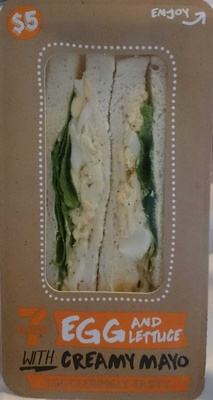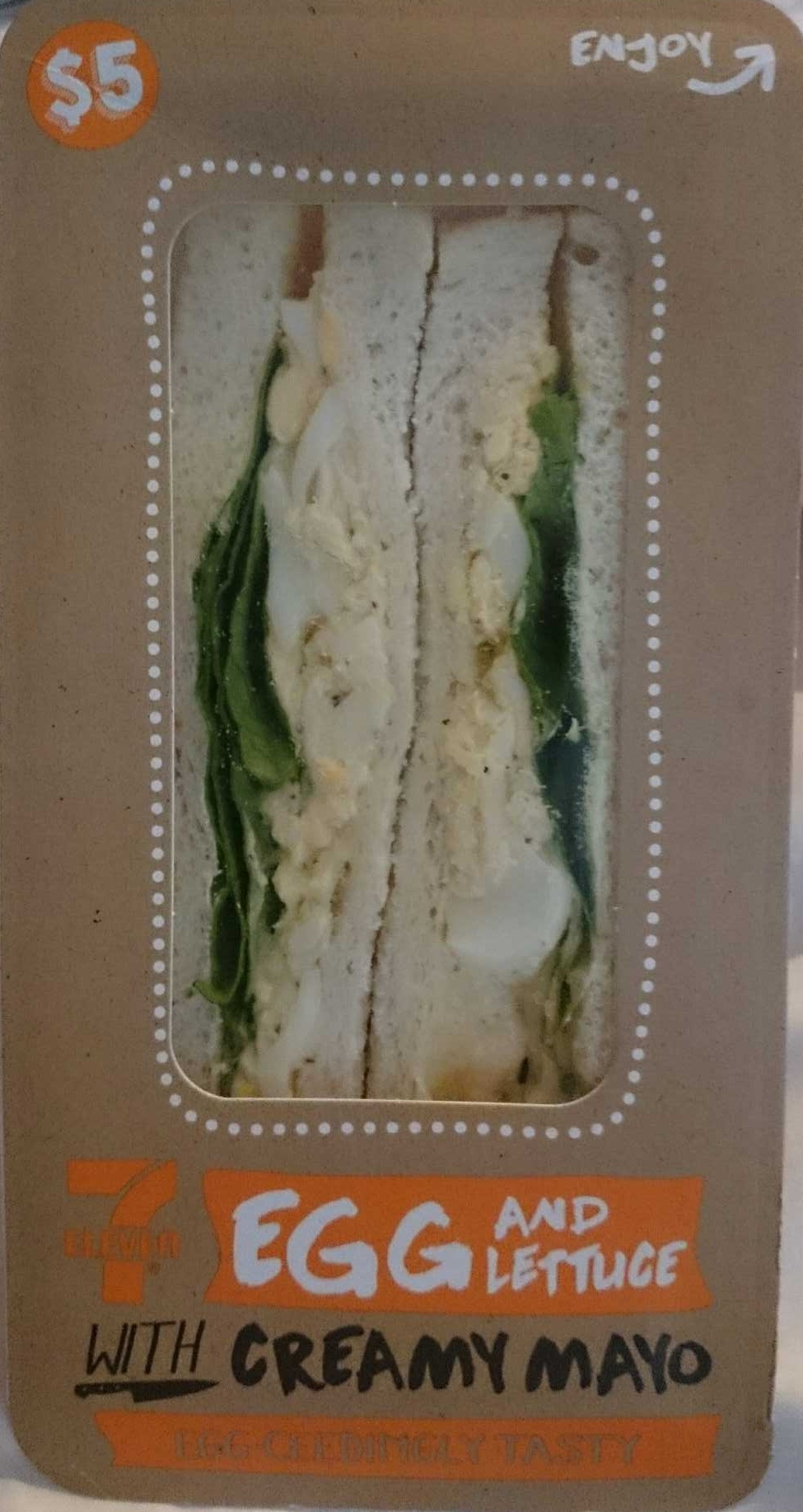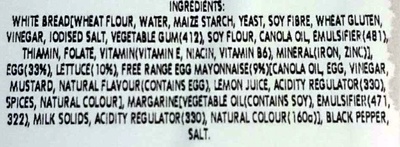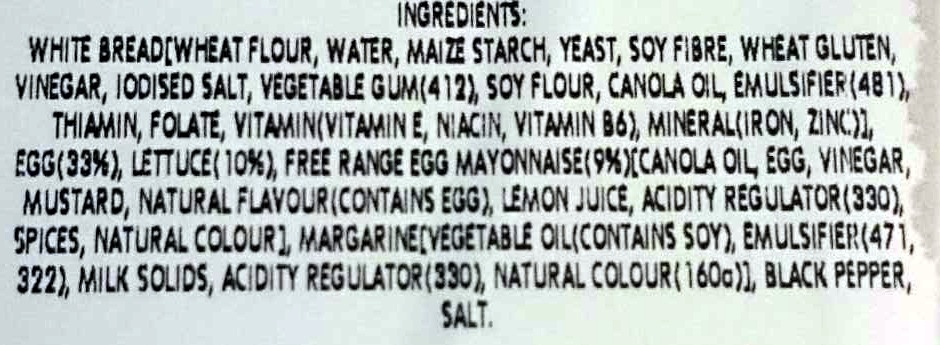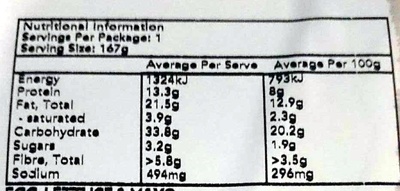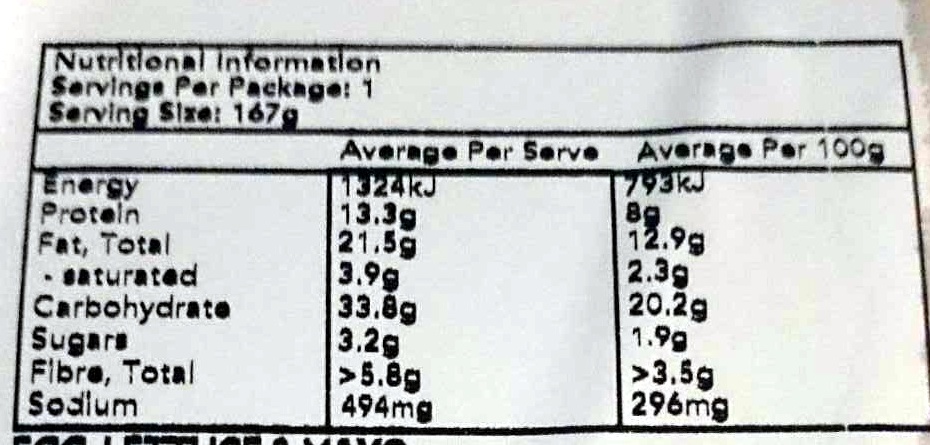Help us make food transparency the norm!
As a non-profit organization, we depend on your donations to continue informing consumers around the world about what they eat.
The food revolution starts with you!
Sandwich egg and lettuce - 7 Eleven - 1 Sandwich
Sandwich egg and lettuce - 7 Eleven - 1 Sandwich
This product page is not complete. You can help to complete it by editing it and adding more data from the photos we have, or by taking more photos using the app for Android or iPhone/iPad. Thank you!
×
Barcode: 9315303006453 (EAN / EAN-13)
Quantity: 1 Sandwich
Brands: 7 Eleven
Categories: Sandwiches, Prepackaged Sandwiches
Labels, certifications, awards: Australian made
Origin of ingredients: Australia
Manufacturing or processing places: Australia
Stores: 7 Eleven
Countries where sold: Australia
Matching with your preferences
Health
Ingredients
-
48 ingredients
WHITE BREAD[WHEAT FLOUR, WATER, MAIZE STARCH, YEAST, SOY FIBRE, WHEAT GLUTEN, VINEGAR, IODISED SALT, VEGETABLE GUM(412), SOY FLOUR, CANOLA OIL, EMULSIFIER (418), THIAMIN, FOLATE, V|TAM|N (V|TAMIN E, NIACIN, VITAMIN B6), MINERAL {IRON, ZINC), EGG(33%), LETTUCE( 10%), FREE RANGE EGG MAYONAISE (9%) CANOLA OIL, EGG, VINEGAR, MUSTARD, NATURAL FLAVOUR (CONTAINS EGG). LEMON JUICE, ACIDITY REGULATOR (330), SPICES, NATURAL COLOUR], MARGARINE (VEGETABLE OIL CONTAINS SOY), EMULSIFIER (471, 322), MILK SOLIDS, ACIDITY REGULATOR (330), NATURAL COLOUR (160a), BLACK PEPPER, SALT.Allergens: Eggs, Gluten, Milk, Mustard, Soybeans, LemonTraces: Soybeans
Food processing
-
Ultra processed foods
Elements that indicate the product is in the 4 - Ultra processed food and drink products group:
- Additive: E160a - Carotene
- Additive: E322 - Lecithins
- Additive: E418 - Gellan gum
- Additive: E471 - Mono- and diglycerides of fatty acids
- Ingredient: Colour
- Ingredient: Emulsifier
- Ingredient: Flavouring
- Ingredient: Gluten
Food products are classified into 4 groups according to their degree of processing:
- Unprocessed or minimally processed foods
- Processed culinary ingredients
- Processed foods
- Ultra processed foods
The determination of the group is based on the category of the product and on the ingredients it contains.
Additives
-
E160a - Carotene
Carotene: The term carotene -also carotin, from the Latin carota, "carrot"- is used for many related unsaturated hydrocarbon substances having the formula C40Hx, which are synthesized by plants but in general cannot be made by animals -with the exception of some aphids and spider mites which acquired the synthesizing genes from fungi-. Carotenes are photosynthetic pigments important for photosynthesis. Carotenes contain no oxygen atoms. They absorb ultraviolet, violet, and blue light and scatter orange or red light, and -in low concentrations- yellow light. Carotenes are responsible for the orange colour of the carrot, for which this class of chemicals is named, and for the colours of many other fruits, vegetables and fungi -for example, sweet potatoes, chanterelle and orange cantaloupe melon-. Carotenes are also responsible for the orange -but not all of the yellow- colours in dry foliage. They also -in lower concentrations- impart the yellow coloration to milk-fat and butter. Omnivorous animal species which are relatively poor converters of coloured dietary carotenoids to colourless retinoids have yellowed-coloured body fat, as a result of the carotenoid retention from the vegetable portion of their diet. The typical yellow-coloured fat of humans and chickens is a result of fat storage of carotenes from their diets. Carotenes contribute to photosynthesis by transmitting the light energy they absorb to chlorophyll. They also protect plant tissues by helping to absorb the energy from singlet oxygen, an excited form of the oxygen molecule O2 which is formed during photosynthesis. β-Carotene is composed of two retinyl groups, and is broken down in the mucosa of the human small intestine by β-carotene 15‚15'-monooxygenase to retinal, a form of vitamin A. β-Carotene can be stored in the liver and body fat and converted to retinal as needed, thus making it a form of vitamin A for humans and some other mammals. The carotenes α-carotene and γ-carotene, due to their single retinyl group -β-ionone ring-, also have some vitamin A activity -though less than β-carotene-, as does the xanthophyll carotenoid β-cryptoxanthin. All other carotenoids, including lycopene, have no beta-ring and thus no vitamin A activity -although they may have antioxidant activity and thus biological activity in other ways-. Animal species differ greatly in their ability to convert retinyl -beta-ionone- containing carotenoids to retinals. Carnivores in general are poor converters of dietary ionone-containing carotenoids. Pure carnivores such as ferrets lack β-carotene 15‚15'-monooxygenase and cannot convert any carotenoids to retinals at all -resulting in carotenes not being a form of vitamin A for this species-; while cats can convert a trace of β-carotene to retinol, although the amount is totally insufficient for meeting their daily retinol needs.Source: Wikipedia
-
E322 - Lecithins
Lecithins are natural compounds commonly used in the food industry as emulsifiers and stabilizers.
Extracted from sources like soybeans and eggs, lecithins consist of phospholipids that enhance the mixing of oil and water, ensuring smooth textures in various products like chocolates, dressings, and baked goods.
They do not present any known health risks.
-
E330 - Citric acid
Citric acid is a natural organic acid found in citrus fruits such as lemons, oranges, and limes.
It is widely used in the food industry as a flavor enhancer, acidulant, and preservative due to its tart and refreshing taste.
Citric acid is safe for consumption when used in moderation and is considered a generally recognized as safe (GRAS) food additive by regulatory agencies worldwide.
-
E418 - Gellan gum
Gellan gum: Gellan gum is a water-soluble anionic polysaccharide produced by the bacterium Sphingomonas elodea -formerly Pseudomonas elodea based on the taxonomic classification at the time of its discovery-. Its taxonomic classification has been subsequently changed to Sphingomonas elodea based on current classification system. The gellan-producing bacterium was discovered and isolated by the former Kelco Division of Merck & Company, Inc. in 1978 from the lily plant tissue from a natural pond in Pennsylvania, USA. It was initially identified as a substitute gelling agent at significantly lower use level to replace agar in solid culture media for the growth of various microorganisms Its initial commercial product with the trademark as "GELRITE" gellan gum, was subsequently identified as a suitable agar substitute as gelling agent in various clinical bacteriological media.Source: Wikipedia
-
E471 - Mono- and diglycerides of fatty acids
Mono- and diglycerides of fatty acids (E471), are food additives commonly used as emulsifiers in various processed foods.
These compounds consist of glycerol molecules linked to one or two fatty acid chains, which help stabilize and blend water and oil-based ingredients. E471 enhances the texture and shelf life of products like margarine, baked goods, and ice cream, ensuring a smooth and consistent texture.
It is generally considered safe for consumption within established regulatory limits.
Ingredients analysis
-
Palm oil content unknown
Unrecognized ingredients: White-bread, Vegetable-gum, 412, 418, V-tam-n, V-tamin-e, Free-range-egg-mayonaise, 330, 471, 322, 330, 160aSome ingredients could not be recognized.
We need your help!
You can help us recognize more ingredients and better analyze the list of ingredients for this product and others:
- Edit this product page to correct spelling mistakes in the ingredients list, and/or to remove ingredients in other languages and sentences that are not related to the ingredients.
- Add new entries, synonyms or translations to our multilingual lists of ingredients, ingredient processing methods, and labels.
If you would like to help, join the #ingredients channel on our Slack discussion space and/or learn about ingredients analysis on our wiki. Thank you!
-
Non-vegan
Non-vegan ingredients: Egg, Egg, Milk solidsSome ingredients could not be recognized.
We need your help!
You can help us recognize more ingredients and better analyze the list of ingredients for this product and others:
- Edit this product page to correct spelling mistakes in the ingredients list, and/or to remove ingredients in other languages and sentences that are not related to the ingredients.
- Add new entries, synonyms or translations to our multilingual lists of ingredients, ingredient processing methods, and labels.
If you would like to help, join the #ingredients channel on our Slack discussion space and/or learn about ingredients analysis on our wiki. Thank you!
-
Vegetarian status unknown
Unrecognized ingredients: White-bread, Vegetable-gum, 412, 418, Thiamin, Folate, V-tam-n, V-tamin-e, Iron, Zinc, Free-range-egg-mayonaise, Mustard, 330, Margarine, 471, 322, 330, 160aSome ingredients could not be recognized.
We need your help!
You can help us recognize more ingredients and better analyze the list of ingredients for this product and others:
- Edit this product page to correct spelling mistakes in the ingredients list, and/or to remove ingredients in other languages and sentences that are not related to the ingredients.
- Add new entries, synonyms or translations to our multilingual lists of ingredients, ingredient processing methods, and labels.
If you would like to help, join the #ingredients channel on our Slack discussion space and/or learn about ingredients analysis on our wiki. Thank you!
-
Details of the analysis of the ingredients
We need your help!
Some ingredients could not be recognized.
We need your help!
You can help us recognize more ingredients and better analyze the list of ingredients for this product and others:
- Edit this product page to correct spelling mistakes in the ingredients list, and/or to remove ingredients in other languages and sentences that are not related to the ingredients.
- Add new entries, synonyms or translations to our multilingual lists of ingredients, ingredient processing methods, and labels.
If you would like to help, join the #ingredients channel on our Slack discussion space and/or learn about ingredients analysis on our wiki. Thank you!
: WHITE BREAD (WHEAT FLOUR, WATER, MAIZE STARCH, YEAST, SOY FIBRE, WHEAT GLUTEN, VINEGAR, IODISED SALT, VEGETABLE GUM (412), SOY FLOUR, CANOLA OIL, EMULSIFIER (418), THIAMIN, FOLATE, V|TAM|N (V|TAMIN E, NIACIN, VITAMIN B6), MINERAL, IRON, ZINC, EGG 33%, LETTUCE 10%, FREE RANGE EGG MAYONAISE 9%, CANOLA OIL, EGG, VINEGAR, MUSTARD, NATURAL FLAVOUR, LEMON JUICE, ACIDITY REGULATOR (330), SPICES, NATURAL COLOUR), MARGARINE, EMULSIFIER (471, 322), MILK SOLIDS, ACIDITY REGULATOR (330), NATURAL COLOUR (160a), BLACK PEPPER, SALT- WHITE BREAD -> en:white-bread
- WHEAT FLOUR -> en:wheat-flour - vegan: yes - vegetarian: yes - ciqual_proxy_food_code: 9410
- WATER -> en:water - vegan: yes - vegetarian: yes - ciqual_food_code: 18066
- MAIZE STARCH -> en:corn-starch - vegan: yes - vegetarian: yes - ciqual_food_code: 9510
- YEAST -> en:yeast - vegan: yes - vegetarian: yes
- SOY FIBRE -> en:soy-fiber - vegan: yes - vegetarian: yes
- WHEAT GLUTEN -> en:wheat-gluten - vegan: yes - vegetarian: yes
- VINEGAR -> en:vinegar - vegan: yes - vegetarian: yes - ciqual_food_code: 11018
- IODISED SALT -> en:iodised-salt - vegan: yes - vegetarian: yes - ciqual_food_code: 11058
- VEGETABLE GUM -> en:vegetable-gum
- 412 -> en:412
- SOY FLOUR -> en:soya-flour - vegan: yes - vegetarian: yes - ciqual_food_code: 20900
- CANOLA OIL -> en:canola-oil - vegan: yes - vegetarian: yes - from_palm_oil: no
- EMULSIFIER -> en:emulsifier
- 418 -> en:418
- THIAMIN -> en:thiamin
- FOLATE -> en:folate
- V|TAM|N -> en:v-tam-n
- V|TAMIN E -> en:v-tamin-e
- NIACIN -> en:e375 - vegan: maybe - vegetarian: maybe
- VITAMIN B6 -> en:vitamin-b6 - vegan: yes - vegetarian: yes
- MINERAL -> en:minerals
- IRON -> en:iron
- ZINC -> en:zinc
- EGG -> en:egg - vegan: no - vegetarian: yes - ciqual_food_code: 22000 - percent: 33
- LETTUCE -> en:lettuce - vegan: yes - vegetarian: yes - ciqual_food_code: 20031 - percent: 10
- FREE RANGE EGG MAYONAISE -> en:free-range-egg-mayonaise - percent: 9
- CANOLA OIL -> en:canola-oil - vegan: yes - vegetarian: yes - from_palm_oil: no
- EGG -> en:egg - vegan: no - vegetarian: yes - ciqual_food_code: 22000
- VINEGAR -> en:vinegar - vegan: yes - vegetarian: yes - ciqual_food_code: 11018
- MUSTARD -> en:mustard - ciqual_food_code: 11013
- NATURAL FLAVOUR -> en:natural-flavouring - vegan: maybe - vegetarian: maybe
- LEMON JUICE -> en:lemon-juice - vegan: yes - vegetarian: yes - ciqual_food_code: 2028
- ACIDITY REGULATOR -> en:acidity-regulator
- 330 -> en:330
- SPICES -> en:spice - vegan: yes - vegetarian: yes
- NATURAL COLOUR -> en:natural-colours
- MARGARINE -> en:margarine
- EMULSIFIER -> en:emulsifier
- 471 -> en:471
- 322 -> en:322
- MILK SOLIDS -> en:milk-solids - vegan: no - vegetarian: yes - ciqual_proxy_food_code: 19051
- ACIDITY REGULATOR -> en:acidity-regulator
- 330 -> en:330
- NATURAL COLOUR -> en:natural-colours
- 160a -> en:160a
- BLACK PEPPER -> en:black-pepper - vegan: yes - vegetarian: yes - ciqual_food_code: 11015
- SALT -> en:salt - vegan: yes - vegetarian: yes - ciqual_food_code: 11058
Nutrition
-
Very good nutritional quality
⚠ ️Warning: the amount of fruits, vegetables and nuts is not specified on the label, it was estimated from the list of ingredients: 10This product is not considered a beverage for the calculation of the Nutri-Score.
Positive points: 8
- Proteins: 5 / 5 (value: 13.6, rounded value: 13.6)
- Fiber: 3 / 5 (value: 3.5, rounded value: 3.5)
- Fruits, vegetables, nuts, and colza/walnut/olive oils: 0 / 5 (value: 10.0244140625, rounded value: 10)
Negative points: 7
- Energy: 4 / 10 (value: 1540, rounded value: 1540)
- Sugars: 0 / 10 (value: 2.9, rounded value: 2.9)
- Saturated fat: 2 / 10 (value: 2.9, rounded value: 2.9)
- Sodium: 1 / 10 (value: 180, rounded value: 180)
The points for proteins are counted because the negative points are less than 11.
Nutritional score: (7 - 8)
Nutri-Score:
-
Nutrient levels
-
Fat in moderate quantity (17.3%)
What you need to know- A high consumption of fat, especially saturated fats, can raise cholesterol, which increases the risk of heart diseases.
Recommendation: Limit the consumption of fat and saturated fat- Choose products with lower fat and saturated fat content.
-
Saturated fat in moderate quantity (2.9%)
What you need to know- A high consumption of fat, especially saturated fats, can raise cholesterol, which increases the risk of heart diseases.
Recommendation: Limit the consumption of fat and saturated fat- Choose products with lower fat and saturated fat content.
-
Sugars in low quantity (2.9%)
What you need to know- A high consumption of sugar can cause weight gain and tooth decay. It also augments the risk of type 2 diabetes and cardio-vascular diseases.
Recommendation: Limit the consumption of sugar and sugary drinks- Sugary drinks (such as sodas, fruit beverages, and fruit juices and nectars) should be limited as much as possible (no more than 1 glass a day).
- Choose products with lower sugar content and reduce the consumption of products with added sugars.
-
Salt in moderate quantity (0.45%)
What you need to know- A high consumption of salt (or sodium) can cause raised blood pressure, which can increase the risk of heart disease and stroke.
- Many people who have high blood pressure do not know it, as there are often no symptoms.
- Most people consume too much salt (on average 9 to 12 grams per day), around twice the recommended maximum level of intake.
Recommendation: Limit the consumption of salt and salted food- Reduce the quantity of salt used when cooking, and don't salt again at the table.
- Limit the consumption of salty snacks and choose products with lower salt content.
-
-
Nutrition facts
Nutrition facts As sold
for 100 g / 100 mlAs sold
per serving (167g)Compared to: Sandwiches Energy 1,540 kj
(368 kcal)2,570 kj
(615 kcal)+62% Fat 17.3 g 28.9 g +121% Saturated fat 2.9 g 4.84 g +22% Carbohydrates 33.6 g 56.1 g +35% Sugars 2.9 g 4.84 g +23% Fiber > 3.5 g > 5.85 g -38% Proteins 13.6 g 22.7 g +31% Salt 0.45 g 0.752 g -50% Fruits‚ vegetables‚ nuts and rapeseed‚ walnut and olive oils (estimate from ingredients list analysis) 10.024 % 10.024 %
Environment
-
Eco-Score not computed - Unknown environmental impact
We could not compute the Eco-Score of this product as it is missing some data, could you help complete it?Could you add a precise product category so that we can compute the Eco-Score? Add a category
Packaging
-
Packaging with a medium impact
-
Packaging parts
(Cardboard)
(Plastic)
-
Packaging materials
Material % Packaging weight Paper or cardboard Plastic Total
-
Transportation
-
Origins of ingredients
Origins of ingredients with a high impact
Origin of the product and/or its ingredients % of ingredients Impact Australia 100 %Medium
Report a problem
-
Incomplete or incorrect information?
Category, labels, ingredients, allergens, nutritional information, photos etc.
If the information does not match the information on the packaging, please complete or correct it. Open Food Facts is a collaborative database, and every contribution is useful for all.
Data sources
Product added on by foodorigins
Last edit of product page on by packbot.
Product page also edited by kiliweb, roboto-app, yuka.VkxvbUM3bzdyTkl6dXNZZzNoSHkyUFJUKzRQM0RGK3ZBYllOSWc9PQ.
